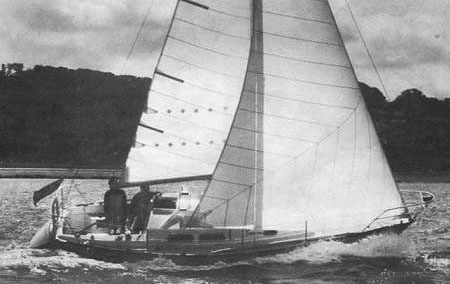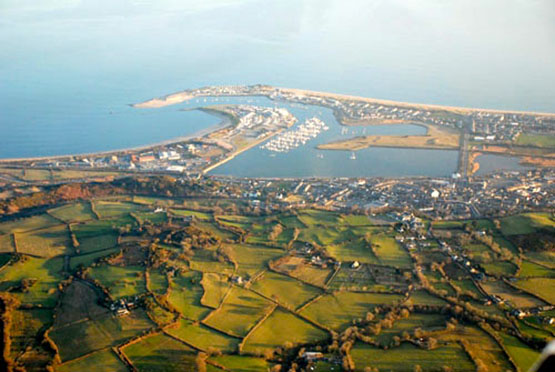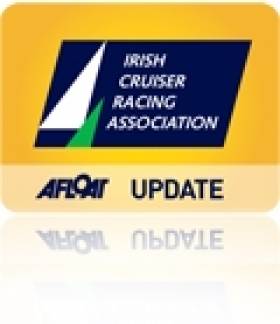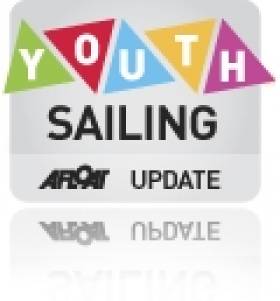Displaying items by tag: Pwllheli Sailing Club
Flags at Half Mast for ISORA Stalwart Huw Tudor, 1934-2023
Tributes have been paid to ISORA stalwart Huw Tudor, who has died in his 89th year.
An estate agent by trade, Huw joined Pwllheli Sailing Club in 1967 as the owner of a small fishing boat named after his wife and daughter.
Within a decade he had ascended through the management ranks to become commodore of the north Wales club for the year 1977-78.
In the meantime Huw became an active ISORA racer along with his son Richard Tudor, going on to compete in several editions of the Fastnet Race and Round Ireland Race while also scoring high-profile wins at Cork Week, among many other achievements.
Gerry Haggas 1919-2016
For Irish sailors who put in the great times with ISORA from the 1970s onwards for three and more decades, it simply didn’t seem like a proper offshore race unless Gerry Haggas from Pwllheli was taking part with his pale blue Elizabethan 30 Sundancer. He and the boat and the ISORA programme became part of each other. Yet Sundancer was by no means the only boat he campaigned in a lifelong contribution to North Wales and Irish Sea competition, though she was the special one.
By the time he was making regular appearances in the frame with the new Sundancer in classic ISORA events, he could look back with satisfaction to a period when he was setting the pace in the development of Pwllheli as a sailing centre, as he served as Commodore of the 1958-founded Pwllheli Sailing Club (Clwb Hwylio) from 1962 to 1964 with the popular and enthusiastic support of his wife Olive, and was a regular contender as well as a developer of sailing against the magnificent backdrop of Snowdonia in Tremadoc Bay.
The late Gerry Haggas chose his boats well - he was most associated with the deservedly successful Elizabethan 30 Sundancer over decades of successful ISORA campaigning.
Yet like many summer sailors in this special area within the sheltering arm of the Lleyn Peninsula, his home was a long way away – it was in Yorkshire, and he was a Yorkshireman through and through in classic style. But he thought nothing of driving many miles over distances which conveniently-placed Irish sailors thought crazy, just to be able to get aboard his beloved boat in those long-gone days when Pwllheli was not yet blessed with a marina, and set out to race into the night.
Gerry’s relationship with Sundancer was rather special, as she was a David Thomas design, but built in Lymington by Peter Webster, a former Yorkshire baker who liked boats so much he upped sticks and moved south to build them beside the Solent. Webster liked this particular design best of all, so although he built many other boat types, he kept the Elizabethan 30 Liz of Lymington to be his pet boat until his death, when it emerged in his will that he’d left the boat to David Thomas, who in turn kept her until a very advanced age as his own boat.
So there’s something about the Elizabethan 30 which is rather special, and there still is though it was 1969 when she first appeared. With a new wave of Half Tonners coming along through the 1970s, Gerry Haggas quietly gave them a hard time. Quite rightly, his older boat rated a little lower, so in your hot new Half Tonner as night came on, you had to be fairly confident that you’d put Sundancer well astern in the myriad of navigation lights. But as sure as God made little apples, as first light came up, there he’d be, right beside you. Only the classic Yorkshire response would do in such circumstances.

Pwllheli as it is today. Gerry Haggas played a key role in its growing popularity as a sailing centre, as he was Commodore of Pwllheli SC in 1962-64 just four years after the club was founded
But while Gerry himself was a quiet man, he had no doubt at all of the proper place of his beloved sailing area in the great scheme of things. I recall one wet evening coming ashore in Abersoch (where of course it rains only once a year) during a well-attended ISORA Week, and there sheltering in the lee of South Caernarvon SC was sailmaker Bruce Banks, a former Olympic sailor and multi-champion.
It turned out he was there because he’d made a new suit of sails for Sundancer, and Gerry (and maybe Peter Webster too) had quietly made it clear that he should travel north from the Solent and spend a day or two at ISORA Week in Tremadoc Bay making sure the guys in Sundancer were doing it right. He enjoyed it so much the “day or two” became the whole week. That was the quiet way with Gerry Haggas. He’d a great 96 years voyage through life. Our thoughts are with his family and especially his son Bill.
WMN
#topper – Royal Cork sailor Adam D'Arcy has won Silver at the Topper World Championships in Pwllheli, Wales. The Fermoy sailor beat 132 competitors from France, Great Britain, India, Japan, Malta, and South Africa. It's a second youth silver for Royal Cork in as many months. In July, ISAF youth silver went to D'Arcy's club–mate Seafra Guilfoyle in the Laser radial class.
As Afloat reported earlier, a total of 11 races were sailed during the regatta in a mixture of weather conditions that concluded this afternoon.
The 16–year–old had a total of 27 points to be on equal points with winner Calum Rosie from the UK, however agonisingly Ireland missed out on Gold on the count-back rule. Last year Ulster sailor Liam Glynn won the world title when the regatta was held in France.
The Gwynedd championship culminated today with four races with podium positions alternating after each race. It made for a nail biting climax to see who would be crowned World Champion. In the end it was Calum Rosie who took the final race win and with it the World Title.
Waterford's Geoff Power finished 10th overall while Peter Gilmore, Heather Spain, Conor Quinn and Hugh Perrette all finished within the top 30.
Top 5 Topper World Championship Results
1. Calum Rosie, UK – 27 pts
2. Adam D'Arcy, Ireland – 27 pts
3. Tom Walker, UK – 28 pts
4. Bella Fellows, UK – 32 pts
5. Oliver Blackburn, UK – 37 pts
Full results here
Fireball World Championships 2015 to be Staged at Pwllheli Sailing Club, North Wales
Fireball International, the UK Fireball Association and Clwb Hwylio, Pwllheli Sailing Club have just launched a presentation announcing Pwllheli as the venue for the 2015 Fireball Worlds. The regatta will take place in Wales between 17th and 28th August 2015.
It will be ten years since the International Fireball World Championships were last held in the UK, and this regatta will represent the first occasion on which the Championship will go to wales. With a substantial domestic fleet of Fireballs in the UK, the event will provide an opportunity to race against some of the best amateur dinghy sailors in Britain and from across the globe. The combination of big fleet, tactical racing combined with the high performance character of the Fireball makes it a very hard act to beat.
The Welsh National Sailing Academy and Clwb Hwylio Pwllheli Sailing Club are a well-known venue in the international sailing world. The club has a wealth of experience in organising major regattas and sailing events and are currently constructing the new Welsh National sailing Academy & Events Centre. The racing areas are a short sail out from sheltered launching conditions off the beach and racing is visible from the shore. Regular south westerly winds and minimal tide provide excellent racing conditions for all, with the beautiful backdrop of the Llyn Peninsula and Snowdonia National Park.
Pwllheli is the unofficial capital of the Llyn Peninsula in Northwest Wales with the Peninsula an Area of Outstanding Natural Beauty and Pwllheli providing an ideal base for exploration and easy access to nearby Snowdonia, Anglesey and the western coast of Wales.
Pwllheli Marina is situated on the south side of the Llyn Peninsula with moderate tides and sea conditions with varied patterns of wind.
CHPSC is located in the Welsh National Sailing Academy complex and boasts a modern building with catering facilities, changing rooms, showers, meeting and protest rooms. The Club is part of the RYA's UK National sailing Academy Network and was selected as a London 2012 Pre-Games Training Camp.
CHPSC have hosted a significant number of major Championships in recent years;
• Worlds: - Finn Masters, Cadets, Laser 2, Mirror, Splash.
• Europeans: - 470 & 420
• Nationals
o 2012: - UK Youths, Finn Worlds Masters, Topper, Optimist, Firefly
o 2011: - Optimist (457 boats), Sprit 15, 420, Finn UK Masters.
o 2010: - 29er, 49er, Finn, Topper, RS400
o 420, Cadets, Optimists (457 boats in 2009), Topper, Contender, RS Classes, Merlin Rocket, GP14, Formula 18, Kestrel, laser, Firefly, Hornet, Scorpion, Osprey, Flying Fifteen, Laser.
Wind
South-westerly winds prevail through most of the year, including the summer months. Long periods of settled weather can occur in August bringing dry sunny weather and light sea breezes. The sailing areas are open to the prevailing south-westerlies, creating unbiased race areas. Large waves or swell are rare in august, small chop of waves will form in onshore winds from SW to S.
Tide
The tides across the race areas are very weak with a peak of 0.3 knots and an average of 0.1 knots. In very approximate terms, the flood tide runs East for the first half of the cycle and Northeast for the second half. The ebb tide runs SW for the entire cycle.
Getting there.
By plane: To Manchester and then by train to Bangor where pick-ups can be arranged.
By ferry: From Rotterdam or Zeebrugge to Hull and then by road across the UK East to West.
From Dublin to Holyhead and then by road.
By road: From all mainland UK destinations.
Accommodation
Haven – "Britain's Favourite Seaside Holiday", 5kms from CHPSC – boasts 5-star on site facilities, including;
• Large heated indoor swimming pool complex with flumes and slides
• All-weather multi-sports courts
• Indoor SportsDrome
• Ropeworks including climbing and abseiling
• Go-karting
• Adventure Golf.
B&B, Apartments (overlooking the beach at Pwllheli's West End), Motor Homes, Caravans & Trailer Tents, Camping.
Quotation.
Chris Gowers, GBR Olympic Sailing Team Head Coach.
"From a sailing point of view, Pwllheli provides the best sailing water in Britain. Clean wind in the prevailing South Westerly makes it the perfect venue. The facilities speak for themselves. The club is incredibly supportive of top sailors, always prepared to go the extra mile. The PSC has a friendly atmosphere and is undoubtedly the premier sailing club in the country."
Welsh IRC National Championships for Pwllheli Sailing Club in August
#welshircnationals – At their annual meeting on 12th September, the GBR IRC Committee approved the IRC GBR Regional Championships for 2014 to be held in Pwllheli.
The date proposed for the Championships is to coincide with the Pwllheli Regatta between 1st and 4th August 2014. An 'Event Organising Committee (EOC)' is now been setup and anyone wishing to contribute should contact Stephen Tudor at Pwllheli SC
Blessington's Finn Lynch Wins British Topper Nationals
From a 15 race series the St. Mary's Carlow school boy took six first places in a fleet of over 300 boats.
The rising star of Irish junior sailing, who is already a world silver medallist in the class, beat Brtiains' Edward Jones by a margin of nine points.
In July, Lynch took control of the Irish Championships in July to count nothing but podium finishes on his way to the national title against a fleet of 66 in Carlingford.
Earlier this year Lynch also cleared up at the ISA Youth Nationals winning seven out of eleven races in Schull.
Topper Results here.


























